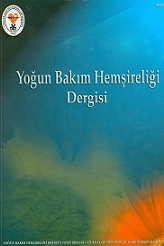Perkütan Translüminal Koroner Anjiyoplasti Sonrası Kanama Komplikasyonu Sıklığı ve İlişkili Risk Faktörlerinin Değerlendirilmesi
Amaç: Bu çalışmada perkütan translüminal koroner anjiyoplasti (PTKA) uygulanan hastalarda kanama komplikasyonu sıklığı ve bu durumu etkileyen faktörler değerlendirildi.Gereç ve Yöntem: Araştırmaya acil ya da elektif olarak PTKA uygulanan 173 hasta (31 kadın, 142 erkek; ort. yaş 53.8±11.3) alındı. Veriler, “Bilgi formu” ve “PTKA Sonrası Kanama Değerlendirme Formu” kullanılarak yüzyüze görüşme yöntemiyle elde edildi. İşlem öncesi ve sonrası, kılıf çekimi öncesi ve sonrası kan basıncı ve etkinleştirilmiş pıhtılaşma zamanı (ACT) ölçümleri yapıldı.Bulgular: İşlem sonrasında 33 olguda (%19.1) dışarıya kanama, 16 olguda (%9.3) hematom görüldü. Hematom görülen olgularda yaş (p=0.001), kadın cinsiyet oranı (p=0.001), ACT (p=0.009), işlem öncesi sistolik arter basıncı (p=0.047), hipertansiyon (p=0.023) ve diyabet (p=0.001) sıklığı anlamlı olarak yüksek bulundu. Dışarıya kanaması olan olgularda ise kadın cinsiyet oranı (p=0.001), yaş (p=0.001), beden kütle indeksi (p=0.001), ACT (p=0.042) ve kan üre azotu (p=0.016) düzeyleri, kılıf çıkarılmadan önceki sistolik arter basıncı (p=0.032), hipertansiyon (p=0.016) ve diyabet (p=0.003) sıklığı ile önceden femoral girişim öyküsü (p=0.049) anlamlı düzeyde yüksek idi. Sigara içen olgularda, içmeyenlere göre kanama komplikasyonu oranı anlamlı olarak daha düşük bulundu (dışa kanama için %42.4 ve %65.7, p=0.043; hematom için %37.5 ve %63.7, p=0.013).Sonuç: İlerlemiş yaş, kadın cinsiyet, hipertansiyon ve diyabet PTKA sonrası kanama ve hematom görülme sıklığını artırmaktadır
Incidence of Bleeding Complications Following Percutaneous Transluminal Coronary Angioplasty and Related Risk Factors
Objectives: The aim of this study was to evaluate the incidence of bleeding complications following percuta- neous transluminal coronary angioplasty (PTCA) and its related risk factors. Materials and Methods: This study involved 173 patients (31 females, 142 males; mean age 53.8±11.3 years) who underwent emergent or elective PTCA. Data were collected with face-to-face interviews using a patient questionnaire and a survey for evaluation of post-PTCA bleeding. Measurements of blood pres- sure and activated clotting time (ACT) were made before and after both PTCA and sheath removal. Results: After PTCA, the incidences of bleeding and hematoma were 19.1% (n=33) and 9.3% (n=16), respectively. Patients with hematoma exhibited signifi- cantly higher levels or frequencies for age (p=0.001), female gender (p=0.001), ACT (p=0.009), preproce- dural systolic blood pressure (p=0.047), hypertension (p=0.023), and diabetes (p=0.001). Patients with bleed- ing had significantly higher levels or frequencies for the following: age (p=0.001), female gender (p=0.001), body mass index (p=0.001), ACT (p=0.042), blood urea nitrogen (p=0.016), systolic blood pressure before sheath removal (p=0.032), hypertension (p=0.016), dia- betes (p=0.003), and history of previous femoral inter- vention (p=0.049). The incidences of both hematoma and bleeding were significantly lower in smokers com- pared to nonsmokers (for bleeding 42.4% vs. 65.7%, p= 0.043; for hematoma 37.5% vs. 63.7%, p=0.013). Conclusion: The incidences of bleeding and hema- toma following PTCA are associated with increased age, female gender, diabetes, and hypertension
